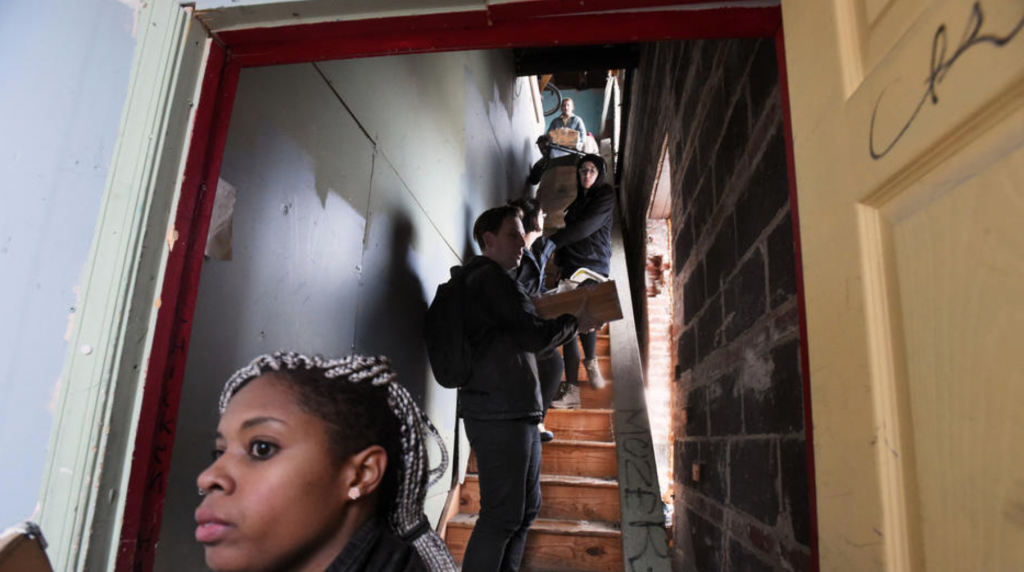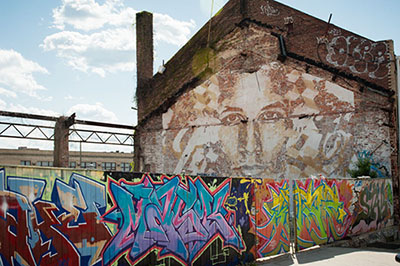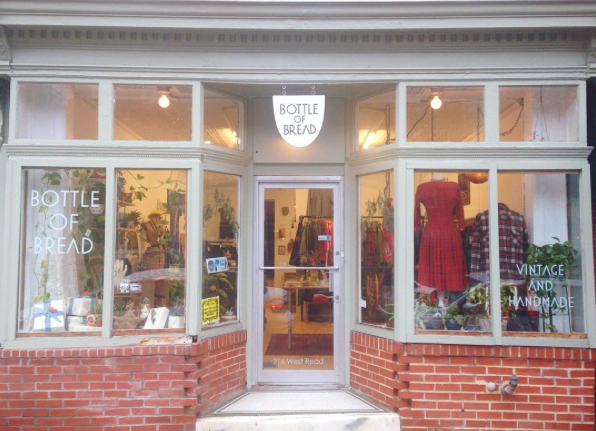How To Move Forward from Baltimore’s Bell Foundry Eviction Debacle by Cara Ober
On Monday, December 5, dozens of Baltimore-based artists were evicted from The Bell Foundry, a warehouse arts space on Calvert Street in the Station North Arts District. The building has provided a home to local theater groups, galleries, artist and recording studios, as well as apparent living spaces which were, technically, illegal.
After last weekend’s tragic fire at Ghost Ship in Oakland, CA, an art and music warehouse space where 36 people lost their lives, the plight of artists has attracted national attention.
Although Baltimore City officials said that the Ghost Ship fire was not their motivation, that an anonymous tip was the impetus, city fire marshals condemned and boarded up the building, calling the conditions “deplorable” and “a tragedy waiting to happen.” After their unannounced visit, the inspectors cited four main violations: “no valid permit, unsafe conditions, use of flammables and combustibles, and unlawful removal of beams from the ceiling.”
Katy Byrne, deputy assistant commissioner for litigation in the city housing departments’ permits and code enforcement division, said in a recent Baltimore Sun article that,”[There were] so many major safety violations that there was no option but to immediately evacuate the building and evict the dozens of artists who were tenants there.”
Byrne cited that “ceiling beams intended to hold the roof up had been removed; major appliances like a stove were plugged into an ungrounded, overwhelmed electrical system; lights were hung from flammable rope; combustible and flammable chemicals were stored near wood and other debris.” She also said that the Bell Foundry’s unsanctioned public assembly space with a stage and bar had insufficient means for getting people in and out and that there was evidence of a past electrical fire.
 The Bell Foundry building in Baltimore has been the recent headquarters of the Baltimore Rock Opera Society
The Bell Foundry building in Baltimore has been the recent headquarters of the Baltimore Rock Opera Society
Although the violations and concerns for the lives of Bell Foundry residents appear to be valid, the city’s treatment of residents matches the “deplorable” conditions city officials described there.
After the inspection, artists were given just one hour to clear out of their studios and homes. The city then boarded up the doors, prompting a strong outcry against treatment that seems disorganized at best and cruel at worst, with artists citing “human rights violations” on the part of the city in their prompt eviction with no plan for assistance or relocation.
Since Monday, the art community and national press has rallied around the evicted artists. A GOFundMe campaign, founded by “local filmmaker, activist, & Bell Foundry frequenter” Emily Eaglin, raised close to $17,000 in one day from just over 500 donors. The site says that the money will help with relocation costs and legal fees and the message from the public is loud and clear: people want to show their support for the artists in their time of need.
According to Eaglin at the funding page, “This reactionary ambush under the guise of a fire hazard (when they were well aware of this situation and possible code violations for much longer) echoes the biases of an unjust system with prejudices against a majority of people living in Baltimore. Many of the Bell Foundry’s artists were POC & Queer identifying, who in fact had a legal lease. The city has not offered them relocation assistance as it is needed and tonight many are left in darkness.”
The plight of artists, both their treatment by city officials and their desire for safe, affordable, communal housing space has generated a national debate in conjunction with the Ghost Ship fire.
Loss of life, and living with this constant possibility, is not an acceptable tradeoff for affordable housing. Evicting those who are building this city’s cultural ecosystem and offering no recourse is not acceptable either.
So many tragic events have occurred in the past week, so many lives lost. This is an unwelcome wake-up call that we, as a community and as a country, reconsider the value of our creative workers and stand up for their safety.
What can be done to protect the rights to freedom, free speech, and pursuit of happiness for all citizens? How can a city offer realistic and affordable options for creative living and work?
In order to take creative risks and build a significant cultural impact, artists need spaces that they can afford, but this risk shouldn’t include one’s life. Ghost Ship’s tragic fire has illuminated the precarious nature of such a lifestyle, dependent upon the benevolent or predatory nature of landlords and their tacit ignorance of code violations, as an unhealthy and unfair compromise.
What can be done to avoid a future tragedy? What can we do here in Baltimore to establish equitable and inclusive housing practices for artists?
 Baltimore artists move their things out of The Bell Foundry (Baltimore Sun)
Baltimore artists move their things out of The Bell Foundry (Baltimore Sun)
Artists:
It’s unfair that responsibility always falls on artists heaviest and first, but we are in need. We have to become better advocates for ourselves. We need to come together to form voting and advocacy groups, like Citizen Artist Baltimore. We need to acquaint ourselves with effective Harm Reduction practices, and insist that our landlords implement them.
Please read Harm Reduction For DIY Venues and Safer Spaces as a start to this process. Please consider the very real possibility that your life could be in danger in any building, especially a repurposed industrial one, and take your safety seriously. Please reach out to the press, your governing officials, and the philanthropic community and make your needs and concerns known.
Landlords:
A benevolent blind eye towards safety violations is not acceptable. No more land banking. No more renting sub-standard spaces to artists because they’re the only tenants desperate and creative enough to make the best of a bad situation.
At the Bell Foundary, one of the landlords, Joseph McNeely, is well known as a supporter of the arts and arts districts. He claimed to the Baltimore Sun to know little about the alleged violations. He said that his tenants were required to obtain any permits needed to use the building, that it was not zoned as a living space, and that they “were supposed to run any modifications to the building past him.”
This all sounds big-hearted until you consider that these artists were paying rent to McNeely (and partners) every month for a building with numerous health hazards and unnecessary risks. Bottom line, it is the landlord’s responsibility to provide a safe place in exchange for rent money, and this appears not to be the case at the Bell Foundry. It’s not okay to call yourself a supporter of the arts to under-charge undervalued rent to artists if your building could easily become another Ghost Ship tragedy.

Elected and City Officials:
If you want to receive respect from your constituents, you need to treat them respectfully. If your family members were living in such a situation, how would you want them treated? Would you want your mother or children evicted with one hour’s notice?
What services and assistance could have been offered to those evicted from the Bell Foundry? How could this particular situation and others have been more humane and civil? What are the official practices and regulations concerning eviction in Baltimore City? How can these be amended and enforced to ensure legal, civil, and humane treatment of city residents?
Mayor Catherine Pugh:
On her first day in office, Mayor Catherine Pugh cited the Ghost Ship tragedy and told the Baltimore Sun she will be “working with the arts community” to address needs and that Baltimore values its diversity.
“We value artists living in the city. We have a great arts community. What we don’t want to happen is what we just saw happen in California. We don’t want that same type of condition to happen here,” Pugh said. “We want to make sure wherever they reside, they’re safe and they’re able to continue to contribute to our arts community and our art environment.”
This is, at least, a start. And this acknowledgement is a huge improvement over the silence received so often from previous Mayor Stephanie Rawlings-Blake.
Demand New Public Policy:
Artists, contact your new mayor. Contact your city council. Send letters and make phone calls. Be creative and send beautifully designed pieces that demand attention. Make viral videos. Create publications. Involve non-artists in our fight.
We need to establish communication with city leaders and to advocate for crucial funding for artists. Other cities offer emergency funds, housing programs, and affordable loans for artists. Our city currently offers NONE of these programs. If we don’t ask for city support, we won’t get it. Artists need to conduct research on funding programs in other, more forward-thinking cities and pitch them to those who can get them started.
Currently, artists receive no official funding directly from Baltimore City. NONE. Our arts districts receive no official funding from the city and BOPA is an independent, non-profit arts advocacy group – they are not a city agency.
Other cities put actual funding from tax dollars into their arts districts, communities, and affordable housing initiatives. We need to present models that are working in other places, especially concerning affordability, occupancy, and public space and demand that our city place ACTUAL value in ACTUAL dollars behind it.
 Baltimore artists move their things out of The Bell Foundry (Baltimore Sun)
Baltimore artists move their things out of The Bell Foundry (Baltimore Sun)
Philanthropic Community:
Now is a great opportunity to step up what you do and show that your support for the arts is deep and abiding. It would be relatively easy for several organizations to pull together and fund an affordable housing initiative for artists. These programs exist all over the country and they are working!
Most artists currently cannot qualify for a mortgage. Most artists cannot buy their own building and renovate it. Philanthropic organizations could easily set up a fund to provide no interest loans to artists in order to purchase buildings, grants to cover closing costs, and other services to help artists buy properties in Baltimore while they are still affordable.
If you consider yourself a supporter of the arts in Baltimore and you have access to philanthropic funding, it’s time to put money behind this initiative and to make Baltimore a place where artists, and those who love them, can live – creatively, safely, and affordably, because we will collectively benefit as a city.
NOW is the time to come together for a positive change.
We can actually look to Oakland for a desirable model, going forward. Although the program has been in the works for a long time, Oakland’s Office of the Mayor announced a $1.7 million artist grant program on December 6, made up of “A group of public and private partners team[ing] up to create long-term, sustainable solutions to creating affordable, safe spaces for artists and arts organizations.”
Whether you are an artist, a public official, a concerned member of the public, or a philanthropist, please take a moment and read through this ambitious and positive plan. We all need to understand how these types of initiatives can work here in Baltimore. We need to all work together to make this happen.
 People leave items at one of the makeshift memorials near where 36 lives were lost in a Friday nigh Fruitvale district warehouse fire in Oakland, Calif., on Tuesday, Dec. 6, 2016. (Doug Duran/Bay Area News Group)
People leave items at one of the makeshift memorials near where 36 lives were lost in a Friday nigh Fruitvale district warehouse fire in Oakland, Calif., on Tuesday, Dec. 6, 2016. (Doug Duran/Bay Area News Group)
I am including the official press release from the Oakland announcement because there is so much useful information in it:
Oakland Mayor Libby Schaaf announced $1.7 million in philanthropic funds to support sustainable, long-term solutions to creating affordable, safe spaces for Oakland’s artists and arts organizations. Though this support has been in development for many months, these funds are especially important and prescient in light of the recent Oakland warehouse fire tragedy.
With funding from the Kenneth Rainin Foundation and the William and Flora Hewlett Foundation, the Community Arts Stabilization Trust (CAST) — a nonprofit real estate organization — will launch a new financial and technical assistance program to help arts organizations facing displacement. This philanthropic support will seed a capital fund to allow CAST to initiate a real estate acquisition program in Oakland to create permanently affordable, safe spaces for artists and arts organizations. The Mayor also announced additional city staffing to support arts and culture in Oakland.
These investments come at a critical time, as artists and arts organizations are at risk of displacement due to Oakland’s escalating housing and commercial space costs. Today’s announcements represent recommendations of a multi-disciplinary taskforce that Mayor Schaaf convened in 2015 to help stem the displacement of artists and arts organizations from Oakland.
“The arts are at the center of vibrant and diverse communities, and are critical to neighborhood health and well-being, yet artists and cultural organizations are increasingly vulnerable to instability and displacement. This public-private collaboration and investments are aimed at preventing displacement, growing the capacity of the city’s artists and cultural organizations, and enhancing municipal resources for the cultural sector over the long haul,” said Mayor Schaaf.
Oakland is home to hundreds of arts and cultural nonprofit organizations, and a significant population of working artists, with an estimated economic impact of $53 million per year (2010 study by Americans for the Arts).
New Initiatives to Support Long-Term, Affordable Space for Oakland’s Arts Community
The Kenneth Rainin and William and Flora Hewlett Foundation funding will support the expansion of CAST into Oakland.
CAST will implement several initiatives that together will result in long-term, sustainable solutions for creating affordable and safe spaces for Oakland’s arts community.
CAST’s new two-year pilot initiative, Keeping Space – Oakland, launches December 7, 2016 and will provide technical and financial assistance to arts and cultural organizations that are seeking real estate expertise and funding for their space needs. Through Keeping Space – Oakland, CAST will offer grants up to $75,000 to arts organizations that have been displaced, or are facing displacement, from Oakland. The grants are intended to help arts organizations execute real estate transactions that result in permanent affordable space.
In addition, as part of the Keeping Space – Oakland initiative, CAST is partnering with the Northern California Community Loan Fund (NCCLF), a local nonprofit, to offer technical assistance to arts organizations. Real estate consulting experts at NCCLF will assist Oakland’s arts organizations in gaining the skills they need to navigate real estate projects, including negotiating protective lease terms and acquiring property.
Applications for Keeping Space – Oakland open on December 7, 2016, and are due February 10, 2017. For more information, go to cast-sf.org.
Finally, support from the William and Flora Hewlett Foundation will help seed a capital fund to allow CAST to launch a real estate acquisition program in Oakland to create permanently affordable, safe art spaces. The fund will be used to purchase real estate and lease at below market rates to Oakland artists and arts organizations.
CAST Executive Director Moy Eng said, “Keeping Space – Oakland and our new real estate acquisition efforts are dedicated to ensuring that Oakland’s arts organizations and artists, who are facing immediate space challenges, remain a vital part of our communities through training, funding, and ultimately permanent real estate solutions. When our local artists and arts organizations are firmly rooted, the entire city benefits.”
Shelley Trott, Director of Arts Strategy and Ventures at the Kenneth Rainin Foundation added, “CAST is a proven model for the community to stem displacement in the arts. This innovative approach addresses financial equity issues by profoundly changing the dynamics. We look forward to seeing the impact it will have in Oakland.”
“NCCLF’s Consulting Department has a long history of stabilizing nonprofits through its real estate and financial management services,” said Joanne Lee, Director of Consulting Services. “We are pleased to join our partners at the City of Oakland, CAST, the Kenneth Rainin Foundation, and the William and Flora Hewlett Foundation to preserve artistic resources in Oakland.”
Additional City Staff Resources to Support Oakland’s Arts Community
The Mayor recently appointed Roberto Bedoya, a national thought leader on cultural equity and creative place-keeping, as Oakland’s Cultural Affairs Manager. Bedoya will coordinate city government resources to better support the arts community. He will oversee the City of Oakland’s Cultural Affairs Unit (housed in the Department of Economic and Workforce Development), which provides more than $900,000 in grants to support the arts annually, administer the city’s Public Art Program, and manage a portfolio of special events, film production permitting, and a walking tours program. Bedoya will also provide leadership for new initiatives, such as completing a Cultural Plan for the City of Oakland.
In addition, Mayor Schaaf announced support from the Kenneth Rainin Foundation to fund a two-year mayoral staff position focused on new policies and initiatives to stem the displacement of artists and arts organizations from Oakland. Kelley Kahn, a city planner with experience in economic development, real estate, and the arts, who led the Mayor’s 2015 taskforce, has been appointed to the position. Kahn will work closely with Bedoya and the City of Oakland’s Cultural Affairs Unit.
“Now is our time to solve immediate challenges facing artists and arts organizations, while also developing a work plan and model for how the arts can thrive in our city,” said Bedoya.
The Importance of Public-Private Partnerships
“Tackling the issues of displacement and protecting Oakland’s diverse arts and culture cannot be solved by government alone. Public-private partnerships are essential in addressing these issues faced by so many growing and changing cities,” said Mayor Schaaf. “We are pleased to have the support of the Kenneth Rainin Foundation, the William and Flora Hewlett Foundation, CAST and NCCLF, as we all work to identify tangible solutions.”
Links:
To fund the artists displaced at The Bell Foundry, click here: https://www.gofundme.com/5n-support-for-bell-foundry-evictees
To contact your rep on the Baltimore City Council: http://www.baltimorecitycouncil.com/contact
To contact the Baltimore City Housing Department: http://www.baltimorehousing.org/contactus.aspx
To contact Association of Baltimore Area Grantmakers:
http://www.abagrantmakers.org
To contact the new Mayor of Baltimore:
http://mayor.baltimorecity.gov
*******
Author Cara Ober is Founding Editor at BmoreArt






